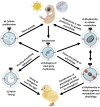Avian circadian clock genes: ontogeny and role for adaptive programming in avian embryos
- PMID: 40626044
- PMCID: PMC12230067
- DOI: 10.3389/fphys.2025.1586580
Avian circadian clock genes: ontogeny and role for adaptive programming in avian embryos
Abstract
Circadian clocks are ubiquitous across almost all organisms, from cyanobacteria to humans, due to a highly conserved mechanism involving a network of negative feedback loops. This molecular oscillator underpins rhythmic oscillations in physiology and behaviour at the organismal level. In vertebrates, both cellular processes and the sensory detection mechanisms underlying rhythmic physiology are relatively well understood. But how these processes develop to optimise tissue-specific rhythmic gene expression is much less understood. Birds possess an intricate, multi-oscillatory core circadian system that governs the biological rhythms of all other tissues. Avian studies document rhythmic expression of genes and hormone production prior to hatching, and yet the consequences of the onset of this process and the interactions with embryonic development have rarely been considered. In this review, we summarise the existing literature on clock gene ontogeny in birds and suggest how rhythmic expression of these genes may develop. Then, by also drawing upon evidence from non-mammalian oviparous taxa, we hypothesise how the development of rhythmic clock gene expression may interact with avian developmental processes and events. Specifically, we highlight how rhythmic clock gene expression may adaptively benefit embryos by phasing rhythms in metabolic and neuro-endocrine systems and we suggest that rhythmic gene expression may play a role in coordinating the physiological systems and behavioural outputs required to initiate hatching. Lastly, we highlight the critical avenues of research that will enhance our understanding of the role of clock genes in avian ontogeny and their ecological relevance, particularly in understanding the impacts of anthropogenic light pollution on developing avian clocks.
Keywords: ALAN; avian ontogeny; circadian; clock gene; hatching; melatonin; mitochondria.
Copyright © 2025 Wellard, Weger, Gachon and Buchanan.
Conflict of interest statement
The authors declare that the research was conducted in the absence of any commercial or financial relationships that could be construed as a potential conflict of interest.
Figures



References
-
- Abraham U., Albrecht U., Gwinner E., Brandstaètter R. (2002). Spatial and temporal variation of passer Per2 gene expression in two distinct cell groups of the suprachiasmatic hypothalamus in the house sparrow (Passer domesticus). Eur. J. Neurosci. 16, 429–436. 10.1046/j.1460-9568.2002.02102.x - DOI - PubMed
-
- Albarran M., Lopez‐Burillo S., Pablos M., Reiter R., Agapito M. T. (2001). Endogenous rhythms of melatonin, total antioxidant status and superoxide dismutase activity in several tissues of chick and their inhibition by light. J. pineal Res. 30, 227–233. 10.1034/j.1600-079x.2001.300406.x - DOI - PubMed
Publication types
LinkOut - more resources
Full Text Sources

